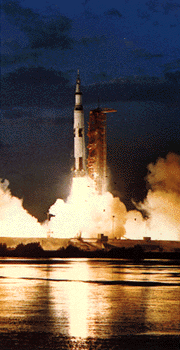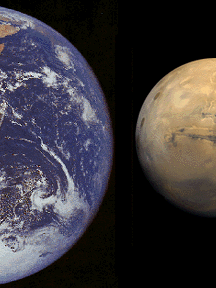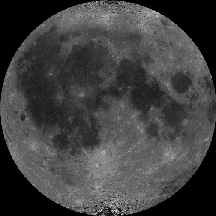Clementine's image of the near-side of the Moon
Click on image for full size
NASA
Headlines declare (12/2/96): Ice patches seen on Earth's moon
Radar images of the Moon's surface taken by American Defense Departments's
Clementine lunar probe have pointed to the possibility of finding water on
the Moon. The images of the Moon's south pole region show a patch of
ice
about 16 feet thick and roughly the size of four football fields.
One theory suggests that the source of ice was a comet which hit the Moon's
surface
some 3.6 billion years ago. Water from the icy comet was collected in the bottom
of
the crater where temperatures fall as low as -230 C. Because moon has no atmosphere,
comets do not burn up as they approach its surface.
Upon
impact with the Moon's surface, gaseous matter from comets hangs around as a
cloud. Water
molecules from this cloud get trapped in extreme cold regions, finally
depositing as
ice. The scientist now theorize that vapor from comet impacts drifted towards
the pole
where it got trapped in extreme cold and turned into ice.
The discovery was made two years ago (~1994), but was hushed until now as the data were
being
analyzed. The
evidence of water was collected by a satellite designed to test
technology for
tracking and intercepting hostile missiles. The Clementine mission used the Moon
as a mock target to test missile sensor equipment, but during its two-month
lunar orbit it collected 1.8 million images of over 99.9 per cent of the Moon's
surface. Six visits to the equatorial region of the Moon by Apollo spacecraft turned up
no trace of water. Twelve astronauts, all from the U.S., have walked on the
surface of
the moon, which is about 239,000 miles from the Earth.
You might also be interested in:

How did life evolve on Earth? The answer to this question can help us understand our past and prepare for our future. Although evolution provides credible and reliable answers, polls show that many people turn away from science, seeking other explanations with which they are more comfortable.
...more
To learn more about a specific mission from the Apollo program, the most successful and expensive space program in human history, select one of the links below: Apollo 1 Apollo 7 Apollo 8 Apollo 9 Apollo
...more
In decades past is was accepted that the Moon contained no water. Moon rocks collected by Apollo astronauts (at lunar equatorial regions) contained no traces of water. Lunar mapping performed by the Galileo
...more
Any successful theory must account for everything we know about the Moon now. Those things include the moon seems to be made of the same material as the Earth's upper mantle. the Moon has little or no
...more
Although the Moon does not appear to have a magnetosphere surrounding it, it *is* a magnetic object in space. Scientists think that the magnetism of the Moon's surface is leftover from a time when the
...more
The atmosphere of the Moon may come from a couple of sources, one source is outgassing or the release of gases such as radon, which originate deep inside the Moon. Gases are released from the interior
...more
Any successful theory must account for everything we know about the Moon now, as well as make predictions about future observations. There are three theories about how the moon came to be in place: that
...more
Here's a safe and easy way to make lightning. You will need a cotton or wool blanket. This experiment works best on a dry, cool night. Turn out all the lights and let your eyes adjust to the darkness.
...more












